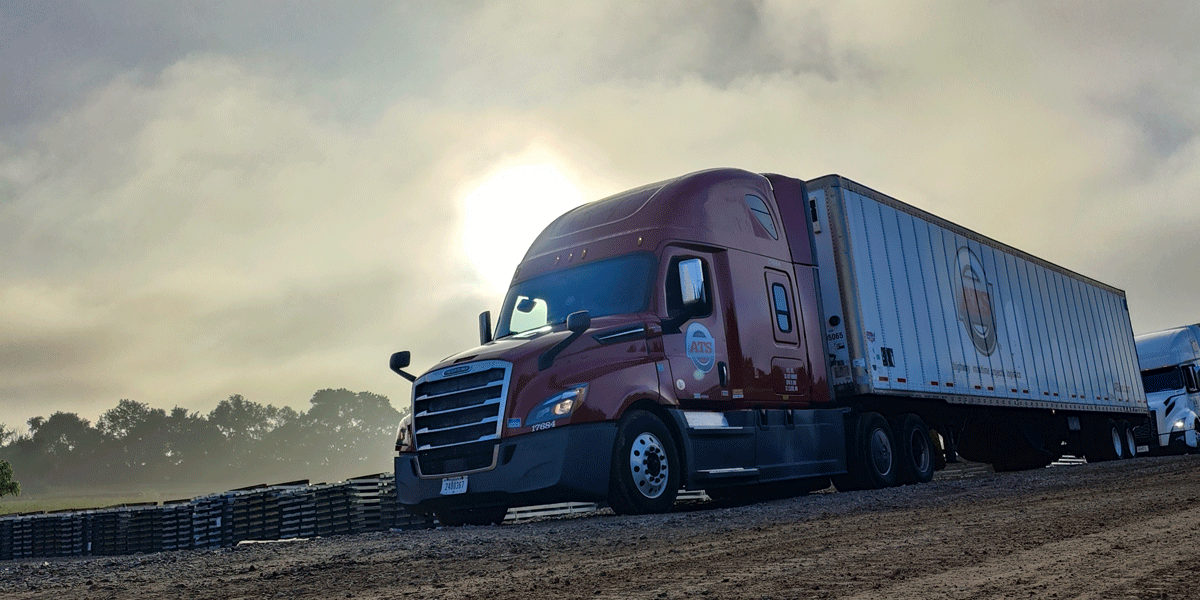How to Crush Your First 90 Days with a New Trucking Carrier
Kally started with ATS in May of 2015 as the orientation coordinator. She moved into a driver services role in March of 2017 and began dispatching drivers as a driver manager in March of 2019. She enjoys being a liaison for drivers and giving them a safe space to chat with someone as they move through their trucking paths.
Revised December 19, 2025
The Roman emperor Marcus Aurelius wrote in his Meditations that "the universe is change." Change is a constant, and while exciting and full of promise, change comes with its own set of challenges, too.
So why am I starting with this? Well, if you've landed on this page, chances are good you've recently made a change, yourself — to driving for a new carrier. And I'm here to help you hit the ground running and crush your first 90 days.
After ten years of experience helping drivers through orientation and as a driver manager at Anderson Trucking Service (ATS), I've learned that the first 90 days with a new carrier are among the hardest on truck drivers. Everything is new and turnover can be high during this time. But if you know what to expect and how to handle it, there's no reason you can't set yourself up for stability and long-term success.
With this article, and my decade of experience in this industry, I’ll help you navigate your transition so you can focus on what matters most: driving, earning, and getting home safely.
Key Points to Consider When Joining a New Carrier
- Set up a meeting with your driver manager within your first week
- Early diligence means big rewards later on. Get to know your lanes, freight, and customers right from the start
- Suspend judgments, and approach things with an open mind (just good advice for life in general)
- Take time to get comfortable with your truck, inside and out
- Clarity is everything. The more you understand your company's policies upfront, the more successful you'll be down the road
- The best drivers are the best prepared

1. Build a Strong Relationship with Your Driver Manager (DM)
This is at number one for a reason. Your driver manager is your lifeline at ATS, so it's a good idea to think of them as your partner. From your first week of orientation, your DM will be your go-to contact for understanding company expectations, managing loads, and getting you the support you need to make your first few months as smooth as possible.
My recommendation? Use that first week to set up a meeting with your DM to get to know each other early, and to go over anything you have concerns or questions about. You'll each get a sense of the others' communication style and mindset, which will lay the groundwork for effective communication going forward. In this business, as in any kind of relationship, communication is everything. This meeting is also your opportunity to talk openly and honestly about:
- Your goals, priorities, and needs, including home time and preferred lanes
- Pay expectations and freight preferences
- Company policies: breakdown procedures, how to request home time and submit paperwork, family emergency support, etc.
- Your communication preferences: text, call, in-person
- Your learning style: hands-on, visual, reading/writing
Pro Tip: Be prepared going into this meeting. Have a few well-thought-out questions at the ready to get the most out of it.
2. Learn Your Freight Lanes and Dispatch Style
Every carrier company has different lanes, freight types, customers, and dispatch rules. Getting to know all of these early on will make a big difference for your peace of mind, not to mention your efficiency and, most importantly, your safety and your earnings. Early diligence sets you up for big rewards down the line.
What All Do I Need to Know?
- Main routes and terminals: the more familiar you are with these, the better you can plan rest breaks, fuel stops, and deliveries
- Freight type: know what you'll be hauling and what it requires for safe handling
- Dispatch style: is it forced or optional?
- Forced dispatch = company assigns loads. Know if you're required to take every load assigned, or if you can choose which to accept
- Optional dispatch = you accept or reject loads. Know how this can affect your schedule, miles, and pay
- Customers: What kinds of customers are you delivering to? What are their expectations for arrival, check-in, and unloading?
3. Adjusting to a New Truck and Technology
Here's more on that whole "change can be a challenge" thing. But it doesn't have to be. With a thoughtful, open approach, you'll quickly be able to build confidence behind the wheel and stay safe out on the road.
So, just how do you get comfortable with a new truck and the latest technology?
- Learn your truck's features: take time to explore its controls, safety systems (adaptive cruise control, lane departure alerts, etc.), and where everything is located
- Use support resources: Our Driver Learning Center has loads (no pun intended) of information on the various tech and safety tools used at ATS. You can, of course, reach out to your driver manager for questions and guidance as well
- Take it slow: Ask for help and make sure you fully understand the company's safety expectations before your first haul
Not to get all "Zen" on you here, but think of your truck as an extension of yourself. The more familiar you are with it, the safer and more productive you'll be.
4. Know Exactly How You’re Getting Paid
You may have just scrolled right down to this part, and honestly, I wouldn't blame you (though, if you did, you should still go back and read the previous sections). Pay is top of mind for many truck drivers, and it's one of the biggest reasons drivers switch carriers, so it's extremely important you understand the expectations on pay and how it works from the get-go. Misunderstandings on this can get messy later on.
Simply put, understanding how you get paid is one of the most important steps in choosing (and keeping) the right driving job. It's no different from any other job in this respect. By asking the right questions (again, refer to this article), you'll gather most of this information from your recruiter, but in that initial meeting with your driver manager (refer back to #1 here), just make sure you've got all the details ironed out and you're on the same page. Things like:
- Pay schedule: know when it'll happen and what all it includes (bonuses, per diem, etc.)
- Pay structure: is it by cents per mile (CPM) or a percentage of the load? (At ATS, it's whichever comes out to be more — every time)
- Documentation and payroll deadlines: Late paperwork means late pay. Know when deadlines are, what forms to submit, and how to submit them on time.

5. Know Where to Turn for Support
For over 70 years, ATS has thrived and grown in the trucking industry, and it's no secret as to how. Our long-term success, through all manner of ups and downs, comes largely from one simple (but extremely important) value that we've always held dear: support for our drivers on and off the road.
Over the past seven decades, we've worked with just about every kind of driver you can imagine: from those just getting their footing to seasoned pros who have been driving trucks for decades — and everything in between. One thing we've noticed? Every driver needs help from time to time, even the most experienced.
Our orientation covers a lot of this information, but it's helpful to go over it all with your driver manager and take notes, too.
What's Important for Me to Know?
- Emergency procedures: How will the company help you in the event of a breakdown or other emergency? (they happen!)
- Training programs: Does the company offer any? What about pairing you up with a driver mentor?
- Who to contact when your DM isn't available: Your driver manager is a person, too, and they may not always be available to you. Know who else you can go to for any roadside assistance or after-hours support.
Pro Tip: Make sure your emergency contacts, support team members, and company policy details are easily at hand: in your phone, in your truck, and in your notes.
Last Stop: Start Strong and Set Up for Success
Hopefully this article has made things a little less...overwhelming for you. Because starting with a new carrier can be a lot to take in. But with the right focus and a positive outlook, your first 90 days will set the tone for a long and successful career on the road.
At ATS, we believe in building strong relationships and an ongoing network of support, and we encourage every driver to:
- Stay proactive
- Communicate openly and honestly
- Take advantage of the resources made to help you
So if you're looking for a carrier that truly invests in your success (and let's face it: what driver isn't), discover what sets ATS apart and see if joining our team is the right next step in your driving journey or contact us today.


